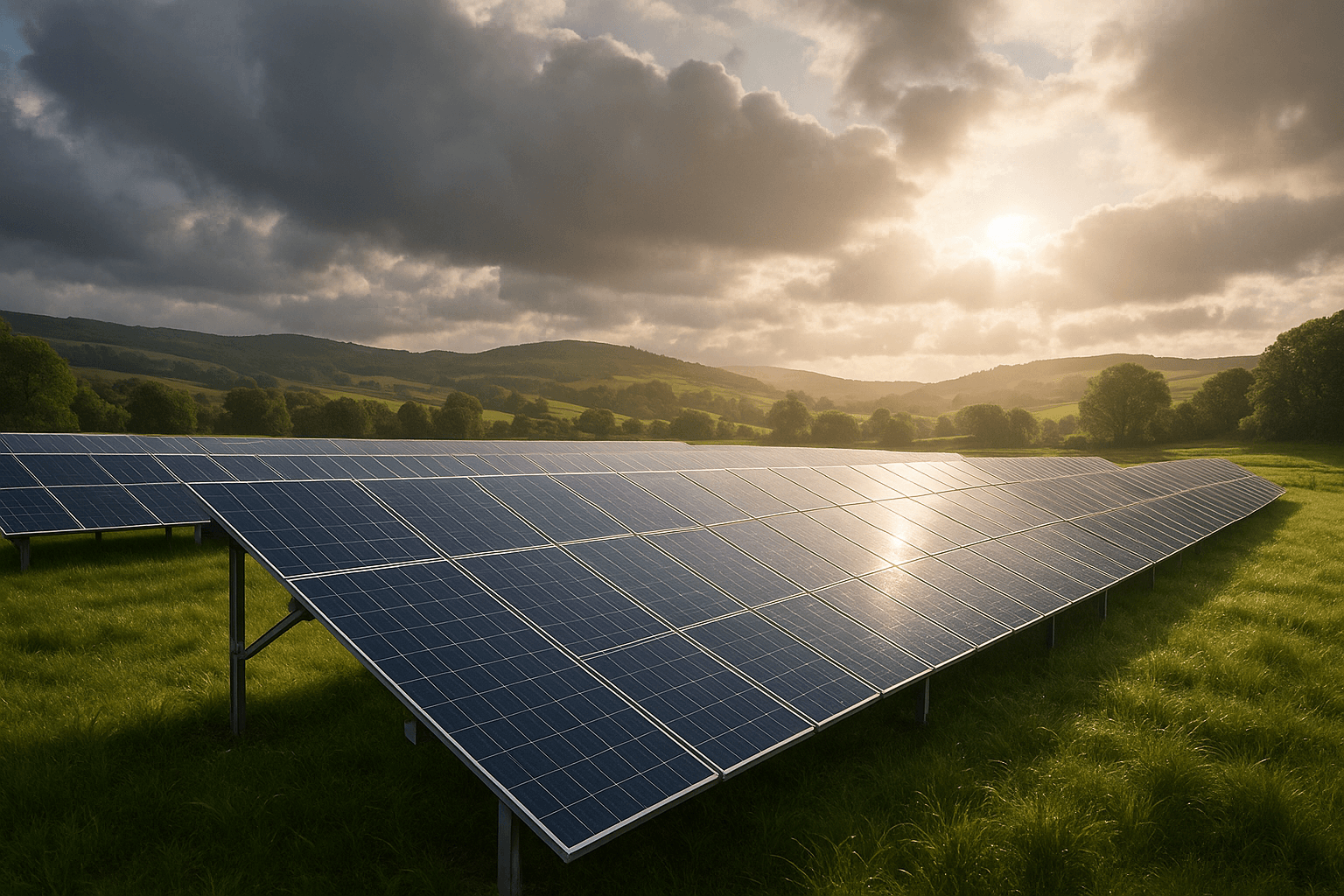Solar panels still work in Northern Ireland’s varied weather, making power on both bright and gray days. While sunny days bring the most energy, new panels can make power from weak light, even in rain. Cool air often boosts how well they work, and rain helps by washing the panels. Having batteries to store energy is key for steady power use all year, more so in short winter days.
Key Points:
- Gray Days: Panels keep making power with spread-out light.
- Rain Helps: Rain washes the panels, boosting how well they work.
- Changes by Season: Summer brings more power due to long days of light, but winter has less.
- Upkeep Tips: Clean and watch the panels often for the best work.
- Battery Use: Battery holds extra power for times with little sun.
A smart setup, good care, and keeping power stored make sure solar setups work well in Northern Ireland’s changing weather.
Power from the Sun on Wet Days
Light Spread and How Well It Works
Even on dark or wet days, solar panels can still make power by catching spread-out light. Their power is less than on bright, sunny days, but they can still turn the light they get into energy. New solar panels are made to work well even when there’s not much light, with single-crystal panels being very good in these times.
Rain can also help out. It washes off dirt and stuff stuck on the panels, which can make them work better. This is really useful in places like Northern Ireland, where the weather can make good use of solar power setups.
Weather in Northern Ireland and Solar Panels
The weather in Northern Ireland has a lot of rain and clouds, but this doesn’t stop solar panels from working well. The cooler air there is good for solar panels. Unlike very hot places, where too much heat can make them work less well, the cooler air here helps them make more energy.
Even though winter days are short and have less sun, the long days in summer make up for that. Even on cloudy days, panels catch spread-out light, which keeps the power coming all year.
What to Expect in Power Each Day
The power your solar setup makes will change with the weather. For example, very cloudy days will have less power than days with some clouds, where bits of direct sun can up the energy made. A lot of rain can cut down power a lot, but a light rain doesn’t do much harm.
To keep your setup working right, it’s smart to watch how it’s doing often. If you see a big drop in power on cloudy days, you might want to check for things like shade, dirt build-up, or water sitting on flat or low-tilt panels.
Cleaning your panels – taking off leaves, dirt, or even snow – can really help. This makes sure that even the weak spread-out light on cloudy days is used as well as it can be.
Sun Power on Bright Days
Work on Clear Days
When it’s bright and sunny, solar panels do their best work, turning direct sun into the most power. This is when they are really good at what they do.
In Northern Ireland, the cool summer heat helps a lot. Solar panels do well at about 25°C, and the cooler summer there keeps them in this great zone for making power.
Season Power in Northern Ireland
Spring and summer mean long days and more sun in Northern Ireland. From May to August, solar panels are often at their top form, thanks to more daylight. In this time, a normal home setup can make about 15-25 kWh each day. That’s enough for most homes, and there’s even some left over.
But, even on bright winter days, the short light hours hold back the power to about 3-5 kWh. This big change is mostly because there are fewer hours of daylight and the sun’s angle is lower.
On the best summer days, the sun’s power hitting the panels can reach up to 1,000 watts per square metre. This rate is what makers use to say how good solar panels are. Even a few hours of strong sun during these long days can boost power a lot. To catch all this power, checking the system often is key.
Keeping an Eye and Care
When power making is high on sunny days, it’s even more key to watch how your setup is doing. Many new solar systems come with apps or online tools that show power as it happens, so you can see if things are going well.
One thing to watch out for is power clipping. This happens when the panels make more power than your inverter can take. If your power seems to top out when it’s very sunny, you might need a better inverter to keep all that power.
Even on sunny days, a bit of dust can drop power by 5-10%. It’s key to keep things clean and check for things like trees or chimneys that block the sun. Luckily, the often rain in Northern Ireland helps keep the panels clean, but sometimes you need to check them yourself.
If problems keep up or you want to make your setup work better, EECO Energy has experts to give advice and help with care to make sure you get the most from your solar setup.
Sun vs. Rain: How They Stack Up
Let’s look at how solar panels do when it’s sunny and when it rains in Northern Ireland. On bright, sun-filled days, solar panels do well with strong, direct sun. This can lead to high sun power levels of about 1,000 watts per square metre, letting the panels work at top speed. But, when it gets cloudy or rains, the sun’s light spreads out, and the power made goes down a lot.
The winter months bring more tough times for making solar power. With fewer daylight hours, a lower sun, and more clouds, the power made drops a lot. Yet, partly cloudy days are not so bad, as panels still get some sun through the gaps in the clouds.
The change in weather shows why it’s key to have battery storage in your solar setup. Batteries let you keep extra power made on sunny days, ready to use when the weather is bad. For example, EECO Energy (https://eeco.energy) in Northern Ireland offers solar options that come with battery storage, keeping your power flow more even despite changing weather.
Knowing how the power changes can help you know what to expect from your solar setup. To make the most of your system, do things that use a lot of power – like washing dishes, clothes, or charging your car – on days when the sun is out and power is high.
sbb-itb-d2d975a
Getting More Power from Sun, No Matter the Weather
Making solar power better in Northern Ireland’s often changing weather takes smart setups, keeping things in good shape, and strong power storage. Whether the sun is out or it’s wet, these steps can help your panels do more.
Setting Up Systems
To make sure your solar panels work well all year, think about how you set them up. Put your panels on a south-facing roof to catch as much light as possible when days are short in winter. You might think about using two-way panels or types made for low light. These grab more sun and don’t lose power if partly in shade.
Keeping Things Running
Even great systems need care to keep going strong. Rain might wash your panels, but you still need to often check them for dirt, trash, or harm that might cut their power. Use smart ways to watch your power levels, and cut back trees close by to keep shadows away.
Storing Energy for Steady Use
To help with the stops and starts of solar power, battery storage makes a big difference. It lets you keep extra power from sunny times to use when it’s cloudy or dark. For help, EECO Energy has the Dyness 10kWh system for £2,400, and Duracell offers a 10kWh system for £3,650 – there are choices to fit what you need and what you can spend.
Final Words
Solar panels in Northern Ireland work well all year, no matter the sky. On bright days, they do better, but even on grey days, they still make power from light. This means your solar setup keeps giving energy, even with the often changing weather.
To get the most from your solar system, you need good planning and upkeep. Place them facing south to catch more sun in all weather. Clean your panels and fix issues fast to boost their work. Adding good power storage helps keep the energy ready, even when the sky is grey.
Batteries are key in handling the ups and downs of the weather. When it’s sunny, save extra power in batteries for use on dark days or at night. EECO Energy gives sure battery help to keep solar power smooth, so it works well all the time.
With new steps forward in solar tech, choosing solar panels is still a smart move. They drop your power bills and cut carbon output, making them a solid, green choice for years.
FAQs
Do solar panels still work in Northern Ireland’s wet and gray weather?
Yes, they do well in Northern Ireland, even with a lot of rain and gray skies. Today’s tech lets solar panels get light even when it’s not sunny, so they make 10% to 30% of their best output on cloudy days. Thus, they keep making power even if the sun isn’t bright.
Also, the cool air in Northern Ireland can make solar panels work better. They tend to do better in mild air than in very hot air. Even with a lot of rain and clouds, solar power is a stable way to cut power costs and bring down the stuff that warms our planet.
How does keeping power in batteries help solar power work better in the weather of Northern Ireland?
Batteries are key in making solar power better. They store extra energy made on sunny days. This means there is still power when it gets cloudy or rains. This gives a steady and sure power source, just right for the changing weather of Northern Ireland.
Plus, battery storage lets homes and companies depend less on the grid by using more of their own made power. The result? More freedom in energy use, less money spent on electricity, and big cuts in carbon releases over time.


